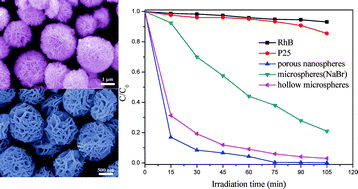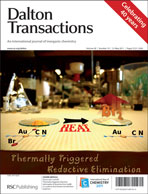BiOBr uniform flower-like hollow microsphere and porous nanosphere structures have been successfully synthesized through a one-pot EG-assisted solvothermal process in the presence of reactable ionic liquid 1-hexadecyl-3-methylimidazolium bromide ([C16mim]Br). The as-prepared samples were characterized by X-ray diffraction (XRD), X-ray photoelectron spectroscopy (XPS), scanning electron microscopy (SEM), transmission electron microscopy (TEM), energy-dispersive X-ray spectroscopy (EDS) and diffuse reflectance spectroscopy (DRS). Possible formation mechanism for the growth of hollow microspheres was discussed. During the reactive process, ionic liquid [C16mim]Br played the role of solvent, reactant and template at the same time. Moreover, the photocatalytic activities of BiOBr flower-like hollow and porous structures were evaluated on the degradation of rhodamine B (RhB) under visible light irradiation. The results assumed that BiOBr porous nanospheres sample showed much higher photocatalytic activity than the conventionally prepared sample and TiO2 (Degussa, P25). The relationship between the structure of the photocatalyst and the photocatalytic activities were also discussed in detail; it can be assumed that the enhanced photocatalytic activities of BiOBr materials could be ascribed to a synergistic effect, including high BET surface area, the energy band structure, the smaller particle size and light absorbance.

You have access to this article
 Please wait while we load your content...
Something went wrong. Try again?
Please wait while we load your content...
Something went wrong. Try again?


 Please wait while we load your content...
Please wait while we load your content...